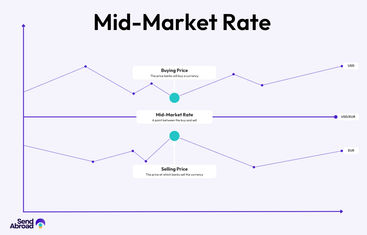The mid-market rate is the accepted exchange rate between two currencies. It’s also known as the interbank rate.
This is because money transfer companies, banks and payment apps add a percentage on top. This is the exchange rate. Then some will and fees to the transfer. In effect this is how they make money.
Example MMR vs. quoted rate
Taking an example of sending $1,000 to Spain.
The mid-market rate for $1 = €0.91*.
So for $1,000 the mid-market exchange rate would result in €905 received.
But with most money transfer companies, banks or PayPal - you won’t get this rate.
For large transactions, this can have a huge impact on the amount received, so it’s worth keeping an eye on.
If a company quoted €0.90, then you would receive around €10 less on a $1,000 transfer.
Some companies do transfer at the mid-market rate. With this, you’ll likely pay fees on top of the transfer, so it’s not always best.
We always recommend comparing the amount you want to send. This will give you a live mid-market rate and with costs from money transfer companies. Banks and PayPal are shown for comparison as well.
*these numbers are examples, please conduct a live search for live rates.
Technicalities behind the MMR
For a slightly more technical definition of the mid-market rate;

Then, third parties like money transfer companies or PayPal, add a markup or margin on top.
This is to carry out a service (in this case, sending money internationally) for you.
How often is the rate changing?
The mid-market rate is constantly changing. During trading hours this is every 60 seconds. This is why it is so important to check before sending.
Why the rate changes
Broadly, economic factors will determine how a rate changes.
But this boils down to:
Supply and demand for a currency: how much is available and how many people want it
Economic factors: inflation rates, big releases like job market data, central bank actions
Politics: new leaders, bad decisions, good decisions.
Global trade and capital flows: how much money is moving around the world, and where is it going
Buy and sell prices
We mentioned earlier the buy and sell price - so what are these?
For any asset there is how much people are willing to pay for something, and how much people want for it. This is the same when selling a car or buying a house.
In this case, we’re talking about currencies.
The price at which people are willing to buy a currency
The price at which people are willing to sell a currency
Together, these create an average, or mid-point: the mid-market rate.
Where can you get the best price vs the mid-market rate
As a quick recommendation, Wise offers money transfers at the mid-market rate.
They do charge fees of 0.33%. However, these can still result in the overall cost of the transaction being lower.
Specifically for UK users, Zing offers transfers at a total cost of 0.2% above the MMR. So cheaper than Wise.
Is sending money at the mid-market rate the best way?
Sending closer to MMR will generally make a money transfer cheaper. Depending on fees and the amount sent, it might not always be the best option.
Fees can be charged as a percentage. If a transfer is at the MMR but with fees of 2%, it will be more expensive than sending at 1% above the MMR with no fees.
Always search for the amount to be sent. It will give you the best possible deal.
Tracking the mid-market rate
Getting a great deal against the MMR can be done through effective tracking. Rate alerts are the simplest way to keep on top of rates.
Currency tools, like ours, will also provide you with data and insights on how the MMR has changed.
Getting the best rate for a transfer
Use a money transfer company based on the amount you want to send
This will ensure you get the best price on a transfer. The amount you send and where you are sending from and to will impact the overall cost.
Do not use PayPal or banks
The markup on the mid-market rate will be higher. These are not the cheapest way to send money.
